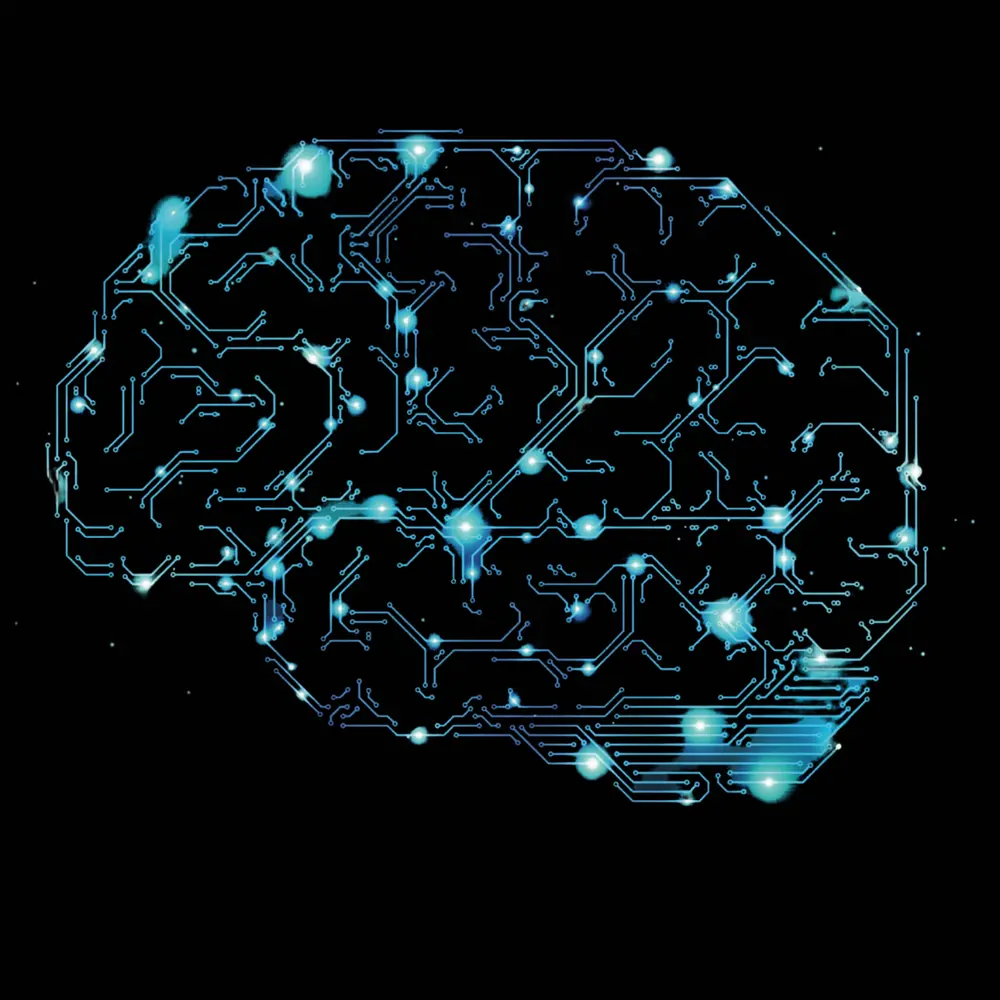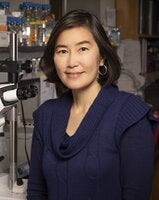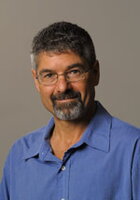
The infinitely complex workings of the human brain have intrigued researchers for centuries. Our understanding of its workings have been limited, not by our curiosity, but by our tools. Now, with the growth of new molecular biology and genomics approaches, big data, and engineering advances that improve imaging, researchers are making advances they could only dream of even a few decades ago.
“Technological breakthroughs have begun to transform neuroscience,” says Catherine Christian, assistant professor of molecular and integrative physiology.
MCB faculty members are deeply involved in all aspects of these efforts, working closely with faculty in chemistry, physics, the Beckman Institute, and elsewhere. Some MCB researchers choose to focus on a specific protein to learn how it interacts within the system; others try to look at the big complicated system in its entirety.
Stephanie Ceman: RNA Sequencing
Stephanie Ceman, associate professor of cell and developmental biology, started out wanting to understand the molecular basis for intelligence. By studying Fragile X, a type of cognitive impairment caused by a single missing gene, she thought she had a relatively simple model, the missing gene codes for FMRP, a protein that binds to RNA. FMRP is highly expressed in neurons, but what does this protein do? Like so many things in biology, the answer turned out to be complicated. In this case, that is because FMRP binds to about four percent of all brain RNAs. That means that the protein helps regulate the translation of numerous RNAs; not so simple after all. Helped by next generation sequencing, Ceman, undaunted, has been helped able to sequence those RNAs.
“Probably the bottom line is that revolutions in sequencing that were driven by the challenge of rapidly and cheaply sequencing human genomes led to the development of technologies that allow people like me to sequence RNAs (the expressed products of DNA),” says Ceman. “Those RNA sequences give insight into cell function. For the first time ever, scientists can sequence RNA to uncover previously unknown regulatory events that affect protein expression in specific cell types like neurons and fascinating tissues like brain.”
This means Ceman can study what happens when the Fragile X protein is turned on or suppressed and also what happens downstream, when the protein is formed. Recently, for example, she has demonstrated that a novel helicase, mov10, is recruited to an RNA that FMRP commonly binds to. The helicase then unwinds it, enabling it to make the protein.
Aided by the use of improved precision of mass spectroscopy in this project, she could more easily identify molecules by their mass on an increasingly fine scale. The story just becomes more and more complicated, but that energizes Ceman. “Complexity drives ingenuity,” she says.
Hee Jung Chung: Genome Wide Sequencing, Micro-array Analysis
Like Ceman, Hee Jung Chung, assistant professor of molecular and integrative physiology, looks at a disease model to see what she can discover about how the brain works. In her case, Chung studies epilepsy.
“Better understanding of the pathogenesis of epilepsy is critical to develop novel therapeutic interventions and early diagnostics for epilepsy,” says Chung.
Epilepsy is a broad term for when neurons misfire chaotically, causing seizures. For Chung, and for most epileptologists, the gateway to understanding is through the ion channel because their input controls the firing of neurons.
One of the projects her lab is focusing on now has to do with the effects of silencing a neuron.When a neuron stops receiving stimulus, it up-regulates its excitability.
“If I were a neuron and I’m not firing, I’m worried (if I’m not receiving any stimulus),” says Chung. “I’m not doing my job. I adjust to up-regulate, to fire more. So after the blockade, now the neuron is more sensitive.”
This is just what homeostatic plasticity is supposed to do. However, if the nerve is silenced for an extended time, then the neurons become hypersensitive and homeostatic plasticity becomes maladaptive.
Chung’s hypothesis is that if homeostatic plasticity does not work properly then it will lead to disease, such as epilepsy. Chung’s lab is making progress uncovering the molecular players.
Using gene-expression profiling and micro- array analysis of those genes affected when a neuron is blocked, the Chung lab found genes that encode potassium ion channels were “highly represented.” This makes sense given the role potassium ion channels play in neuron function. Chung’s hypothesis is that when a neuron is silenced, the transcription of potassium ion channels is reduced. With few potassium channels to inhibit excess electrical activity, the neurons will now fire in an uncontrolled way. Using both gene analysis and electrophysiology, Chung found this to be the case not just for potassium ion channels on the axon, but in all regions of the neuron.
Chung’s next step is to study the effects of homeostatic plasticity in vivo. Her lab has created a model, using chemical tools, by which specific neurons in a mouse brain can be silenced or stimulated at a specific time. She can observe those neurons by tagging them with green fluorescent protein (GFP) and using a comprehensive gene expression array to figure out what genes are affected, all of which will help her team understand structural changes that might be implicated in some forms of epilepsy.
Catherine Christian: Chemogenetics, Optogenetics and UV Uncaging
While Ceman and Chung have focused on synapses, one of the areas Catherine Christian, assistant professor
of molecular and integrative physiology, is investigating involves astrocytes, those “other” cells in the brain. It was thought for a long time that astrocytes, or glia, were merely the glue holding the neurons in place. It turns out they have their own role to play.Thanks to new technologies, that is changing.
“Research in the last 10 or 15 years has shown that astrocytes play major roles in modulating synaptic transmissions,” says Christian.
Research has shown that glia are like the housekeepers and interior designers of the brain. They remove and recycle neurotransmitters, including GABA (an inhibitor) and glutamate (an excitatory molecule), and buffer ions to maintain proper concentration around the neurons.
However, research has been impeded by the lack of techniques to study the glia.
“Astrocytes have been underappreciated because it is hard to manipulate their function without also affecting neuronal function,” says Christian.
Breakthroughs such as optogenetics, chemogenetics and UV un-caging, are enabling researchers to selectively manipulate very specific cells, says Christian. In optogenetics, different wavelengths of light can activate or inhibit cells of interest because the cells are engineered to contain a light-sensitive protein. Using optogenetics on astrocytes, Christian is looking at how astrocytes regulate GABA transmission in the hippocampus.
Experimentally, she is “putting those (light- sensitive) proteins in astrocytes, then triggering them and watching how the astrocytes affect GABA transmission on nearby neurons. Interestingly, we see different effects depending on brain area,” says Christian.
“These findings support the emerging model that not all astrocytes are the same and emphasizes that it’s really important to look at things in different brain areas,” she adds. “That is especially important in clinical application.”
One drawback to optogenetics is that the experimenter has to put a light fiber in the brain, which is invasive. So Christian’s lab also is using chemogenetics, in which cells can be excited or suppressed using chemical means.This procedure is noninvasive and the chemicals can cross the blood-brain barrier, making chemogenetics ideal for Christian’s work and enabling her to manipulate the action of brain cells in real time.
“One can always fix and stain brain tissue to see connections between the cells, but what these techniques allow us to do it in live tissue and see the connections as they are working functionally.”
A third technique that is being used quite successfully in Christian’s lab involves ultraviolet (UV) uncaging. In this case a desired molecule, such as a neurotransmitter, is chemically attached to another molecule (“cage”) by a UV- sensitive bond. When a shot of UV light, such as from a laser, is applied to a tissue bathed in a solution containing the caged neurotransmitter, this releases the neurotransmitter so that it can then bind to receptors in nearby cells.
For example, by tagging GABA, an inhibitory transmitter, Christian can move the molecule to a certain part of the neuron, uncage it, and see how GABA affects the receptors expressed on different parts of the cell.
“We can also prepare small pieces of neuron membranes that contain GABA receptors and examine the response to GABA uncaging when these receptors are placed in different areas of a brain slice, which allows us to look at how
GABA receptors are modulated by local factors, and how this is specific to certain brain regions,” says Christian.
Dan Llano: Optogenetics
Dan Llano, assistant professor of molecular and integrative physiology, like Chung, is investigating plasticity gone bad as he works to elucidate the micro- structure of the brain in the auditory region. In his case, Llano's model has to do with cochlear degradation with aging. As the auditory system ages it can receive wrong information or new information (like tinnitus, which is both wrong and new) and it can lose the ability to focus on a specific stream of sound, for example, in a crowded room. Llano is interested in how those deficits affect connections in the brain’s auditory system. He is hoping that by uncovering the brain’s microstructural connections he can determine when an auditory malfunction is due to a molecular or structural problem or something else entirely.
Llano uses high-resolution optical stimulation, or optogenetics, which enables researchers to use lasers to stimulate or inhibit specific neurons and, thus, see the connections those neurons make. He keeps brain slices alive for 8-12 hours and studies how the individual circuits are connected by using lasers to activate small groups of neurons. Like Christian, Llano also uses UV uncaging techniques for this work.
“We have so much to learn about the organization of any brain system,” he says. “For me, the big question is how one (brain sub-structure) communicates with another. If we can figure out how to label individual sub populations of neurons we can answer this question.”
Thomas Anastasio: Process Algebra Analysis in Biology
Other MCB researchers are working to understand neural systems as the complicated and messy networks that they are. Until very recently researchers could only imagine attempting to perform these kinds of analyses.
Thomas Anastasio uses computer modeling to address what he calls the brain’s “extreme complexity,” and harnesses large quantities of data in the service of a predictive model.
“Big data approaches (e.g. gene chip analysis) will tell you that a thousand different things are potentially important in the functioning of some neural system, and even if you verify a few hundred of those you still end up with a very, very complicated set of interactions,” says Anastasio. “And you can look at the complicated diagram depicting those interactions, and there’s no way you could figure out what is going on. We have to address this complexity computationally.”
Anastasio, associate professor of molecular and integrative physiology, instead takes “factors we know experimentally are involved and try to pull all those together. My whole raison d’être in science is to take concepts and techniques from more technical areas such as math, computer science, and engineering and bring them to biology. As a computational neuroscientist, that’s why I was hired here.That’s what I love to do.”
Anastasio has most recently borrowed techniques such as process algebra and a declarative computer language known as Maude from computer science.
“Imperative computer languages are used to write programs that execute statements in a pre- specified order along a single pathway,” says Anastasio. “Declarative languages, in contrast, are used to write programs that can execute statements in all possible orders, thereby elaborating the pathways of all possible orders of statement executions.”
Maude is one of only a few declarative languages, says Anastasio. Developed by Jose Meseguer, professor of computer science, and others, Maude can model complex and dynamic multi-parameter systems.
“I like Maude because she is extremely powerful, and she was developed here in the computer science department. I was able to get help from her developers when I was first learning.”
Among his many projects, Anastasio has built several models for neurodegeneration using Maude. Most recently, he looked at the effect of hypoxia as a trigger for beta-amyloid accumulation in the brain.
“There is a great deal of experimental and clinical evidence showing that loss of blood flow to the brain, which causes brain hypoxia, can increase the rate of production of amyloid-beta,” says Anastasio.
This model is one of several he has built.
“Alzheimer’s, like all neurodegenerative diseases, is highly multifactorial,” he says. All of his Alzheimer’s models offer “therapeutically relevant predictions in terms of drug combinations that would be more effective than single drugs for reducing amyloid-beta-induced inflammation or synaptic plasticity impairment or for reducing amyloid-beta accumulation itself.”
Whenever someone has had a brain trauma or major surgery, for example, the hypoxia model predicts that a combination of NSAIDs and a drug that blocks Hypoxia Inducible Factor, HIF, should reduce the rate of accumulation of beta-amyloid in the brain.
The next step is to find a bench scientist to test his model and provide results that he can then incorporate back into the model.
Martha Gillette: Noninvasive Computational and Chemical Imaging
Another way to confront the complexity, says Martha Gillette, professor of cell and developmental biology and director of the neuroscience program, is through large, multi-investigator projects such as the BRAIN Initiative (Brain Research through Advancing Innovative Neurotechnologies), a collaborative, public-private research initiative announced by the Obama administration in 2013.
Gillette leads a BRAIN project based on a noninvasive real-time imaging method developed by her collaborator, Gabriel Popescu, associate professor of electrical and computer engineering. The challenge is to image sub- cellular dynamics in tissue that is dense and has a high refractive index. This project also involves high-resolution measurements of neurotransmitter release and stimulation by biocompatible flexible electrodes, technologies developed by Jonathan Sweedler, professor of chemistry, and John Rogers, professor of materials science and engineering, respectively.
The second BRAIN project involves using chemical techniques to analyze composition of cells in the parts of hippocampus where learning takes place. Using Raman Spectroscopy combined with mass spectrometry, Rohit Bhargava, professor of bioengineering, and Jonathan Sweedler, professor of chemistry, are working to measure the vibrational spectra in a cell and then use that to identify the comprehensive chemical profiles of cells and brain tissue. Gillette’s lab provides the essential functional data that are coupled with these high- resolution chemical signatures.Their work will produce a kind of “functional chemical histology” of the brain, she says.
“We can do this because we’re at Illinois,” says Gillette, professor of cell and development biology. “All our progress is because of technology,” she adds.
Funding for much of Gillette’s work is through various BRAIN initiatives. One of the most compelling aspects of BRAIN is that the various federal agencies involved are investing in a diversity of projects. This is, says Gillette, because “they understand there is no guarantee where the next breakthrough will come from.”





